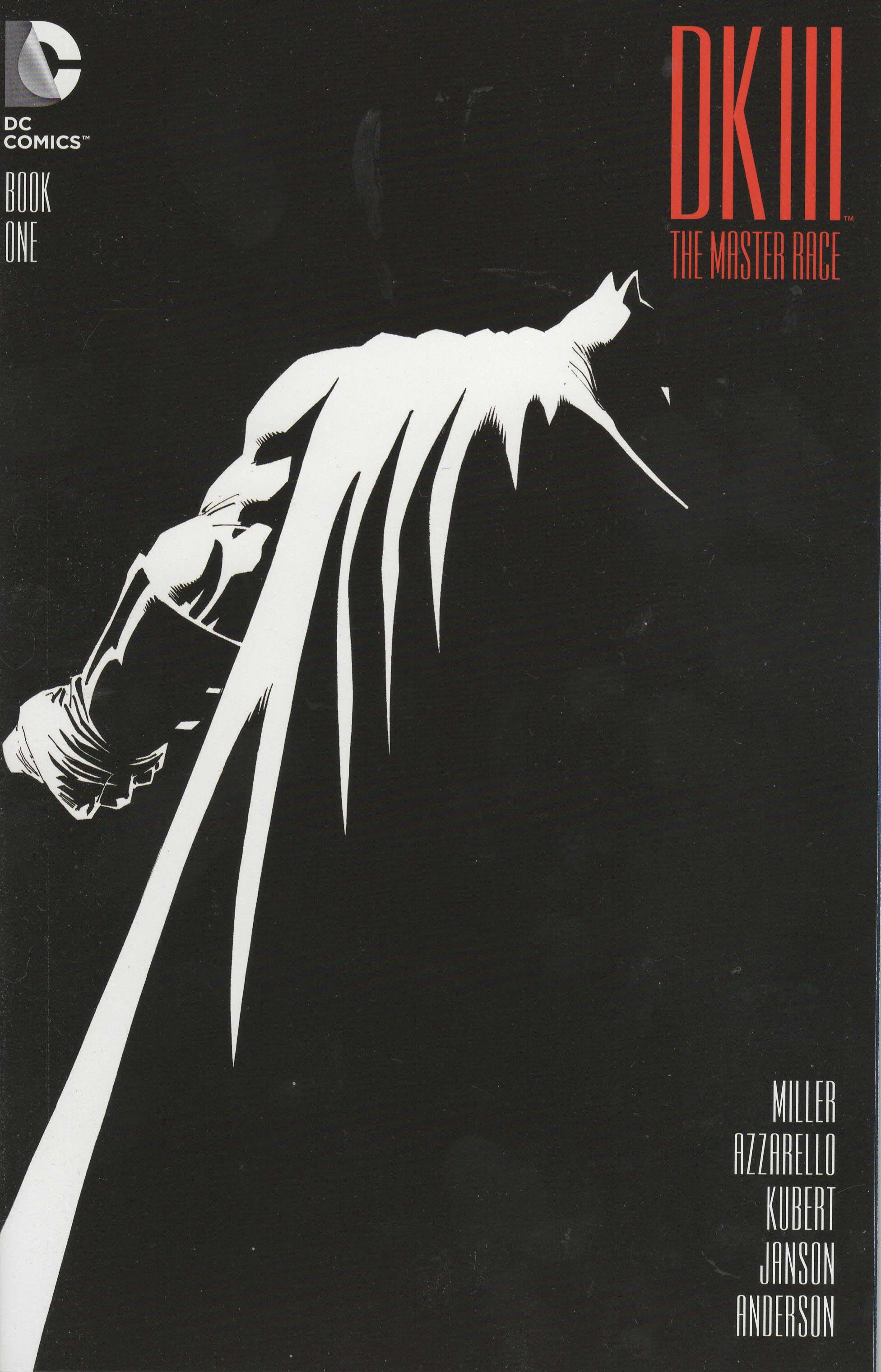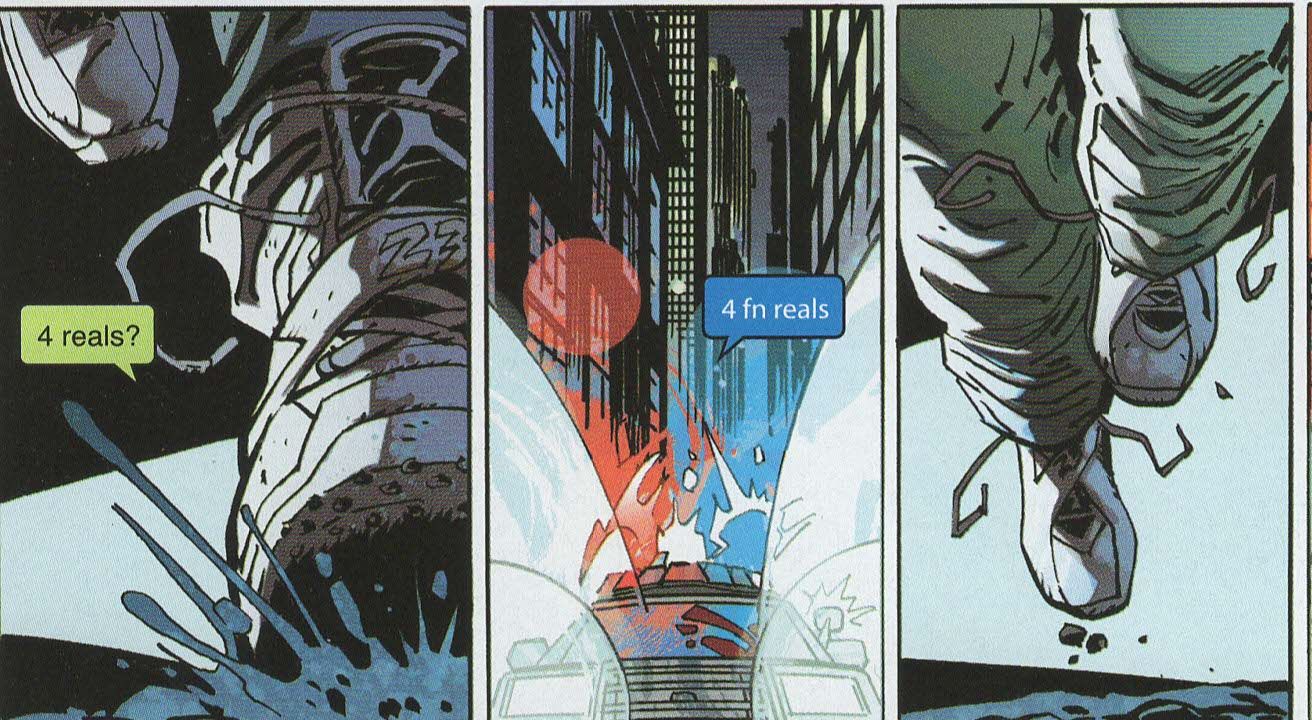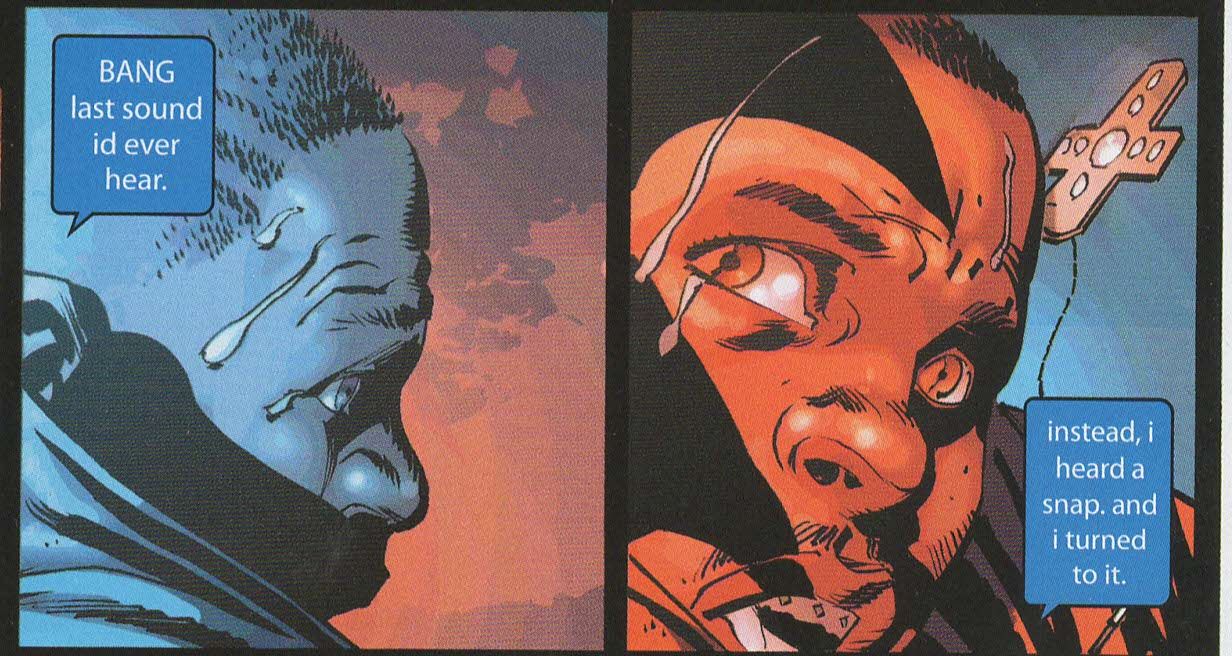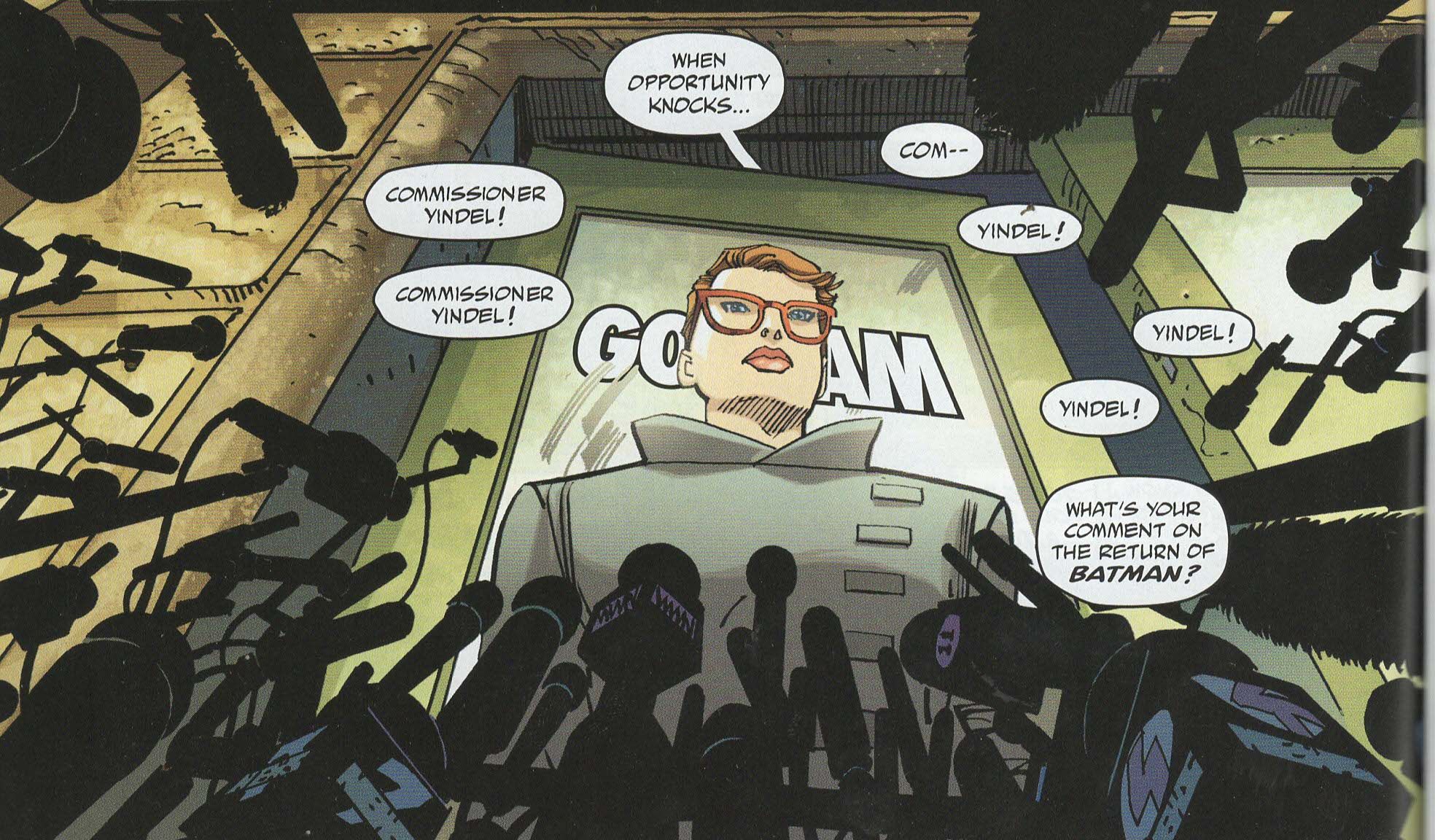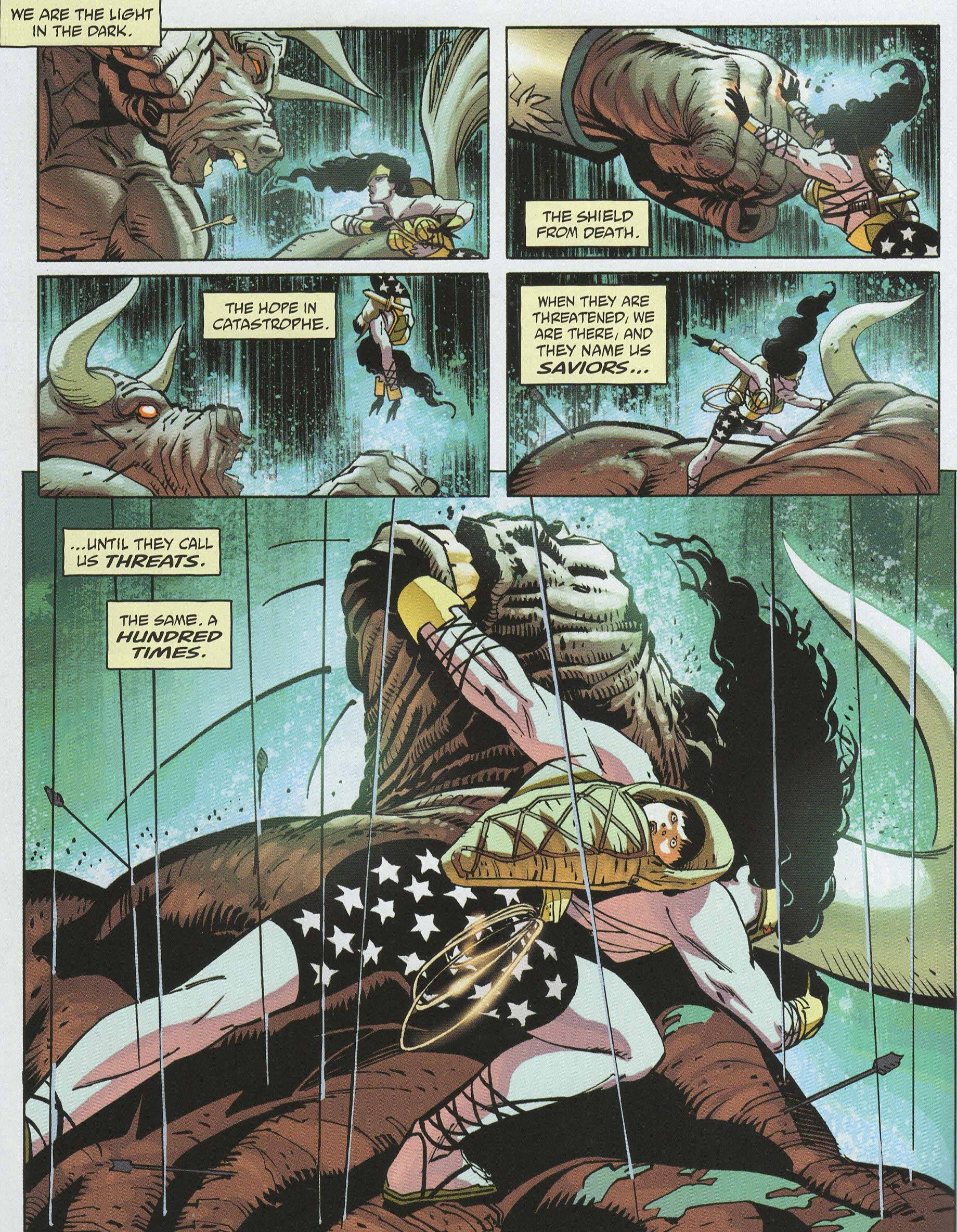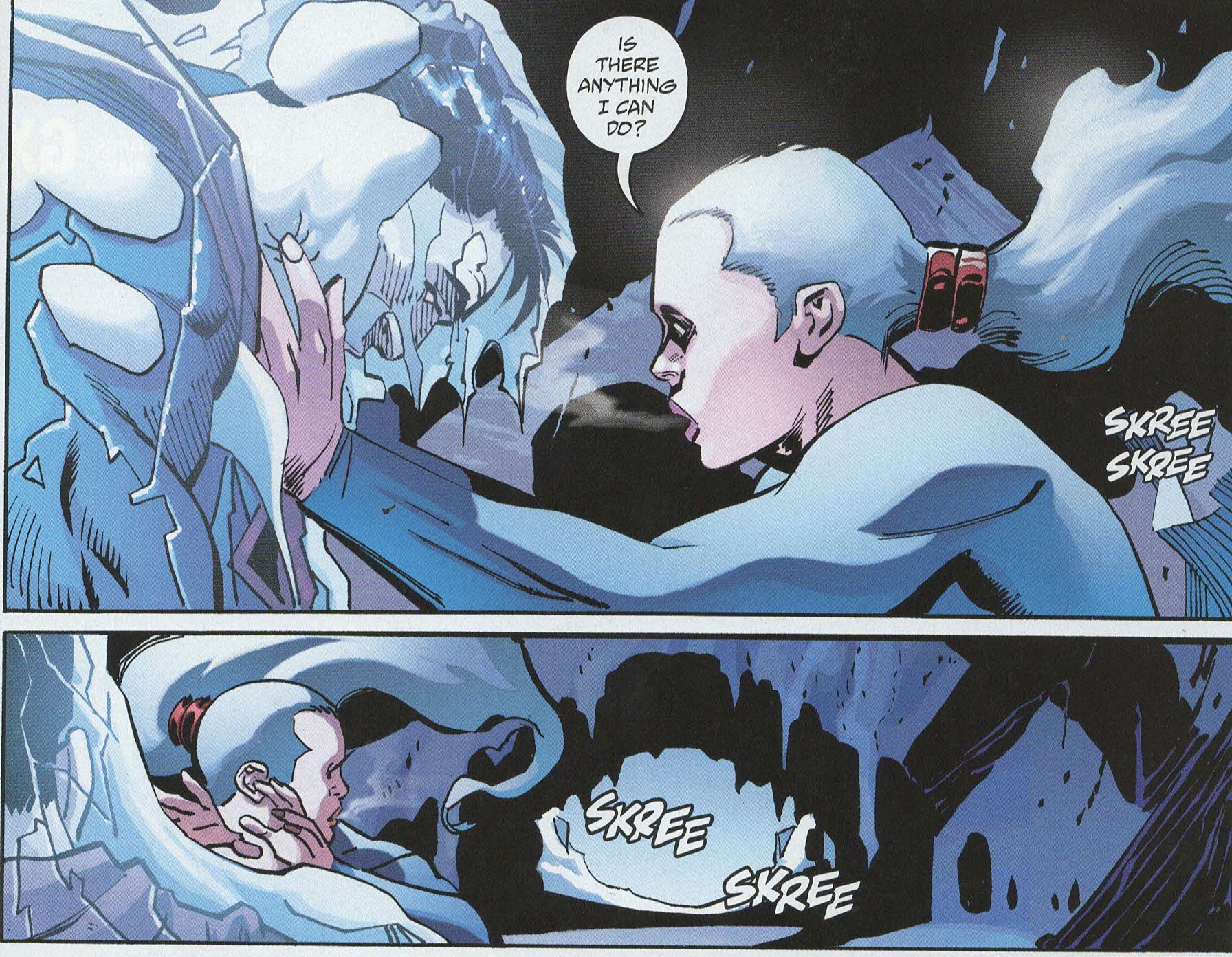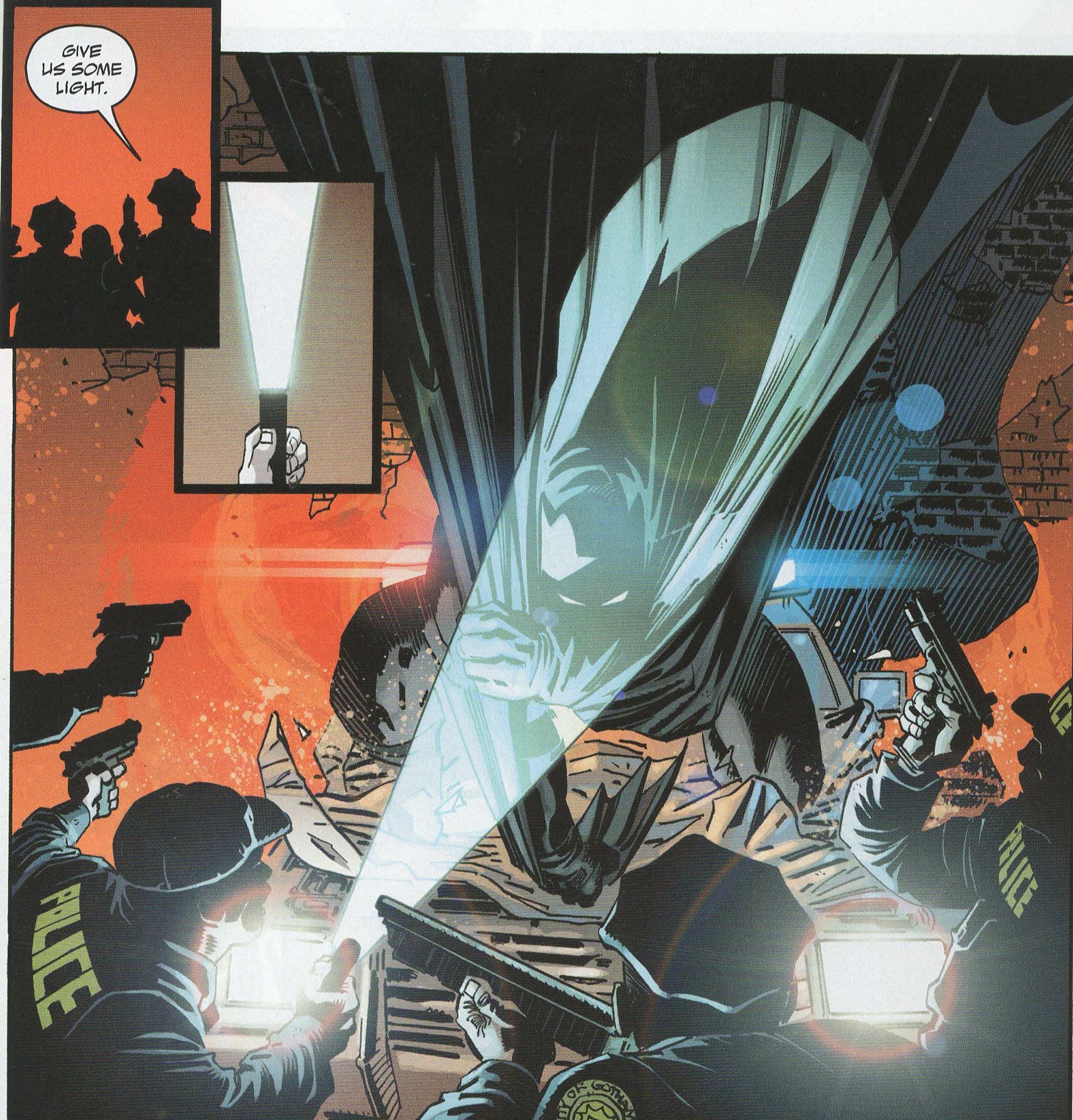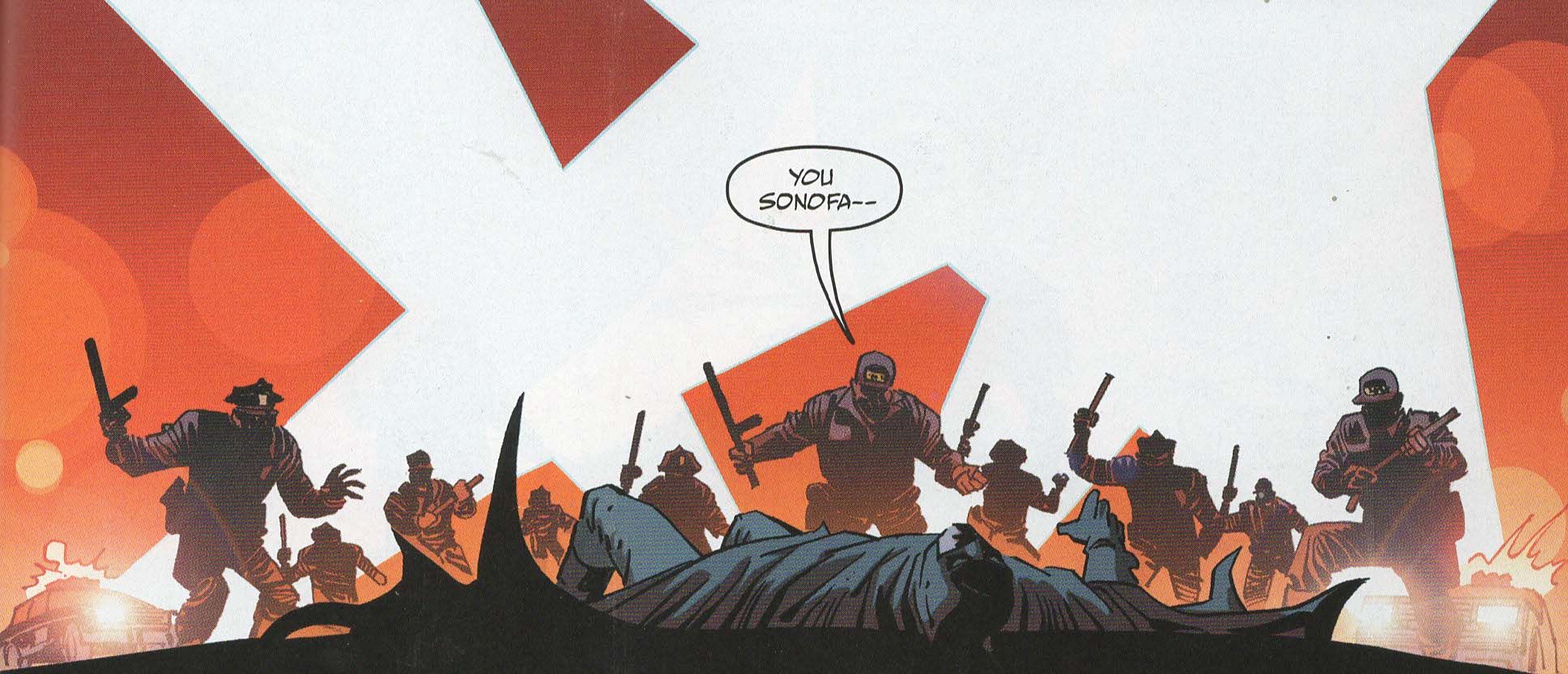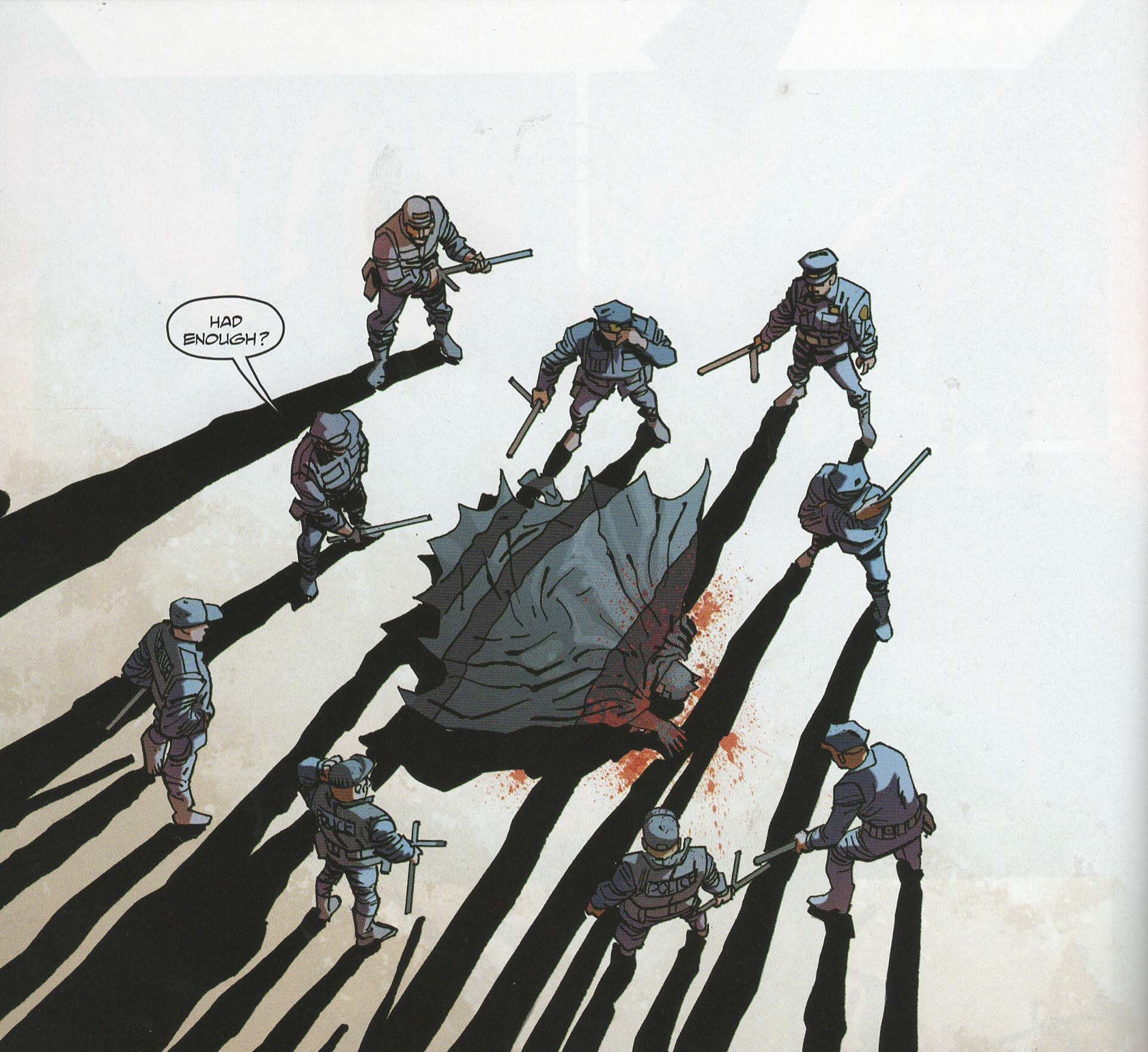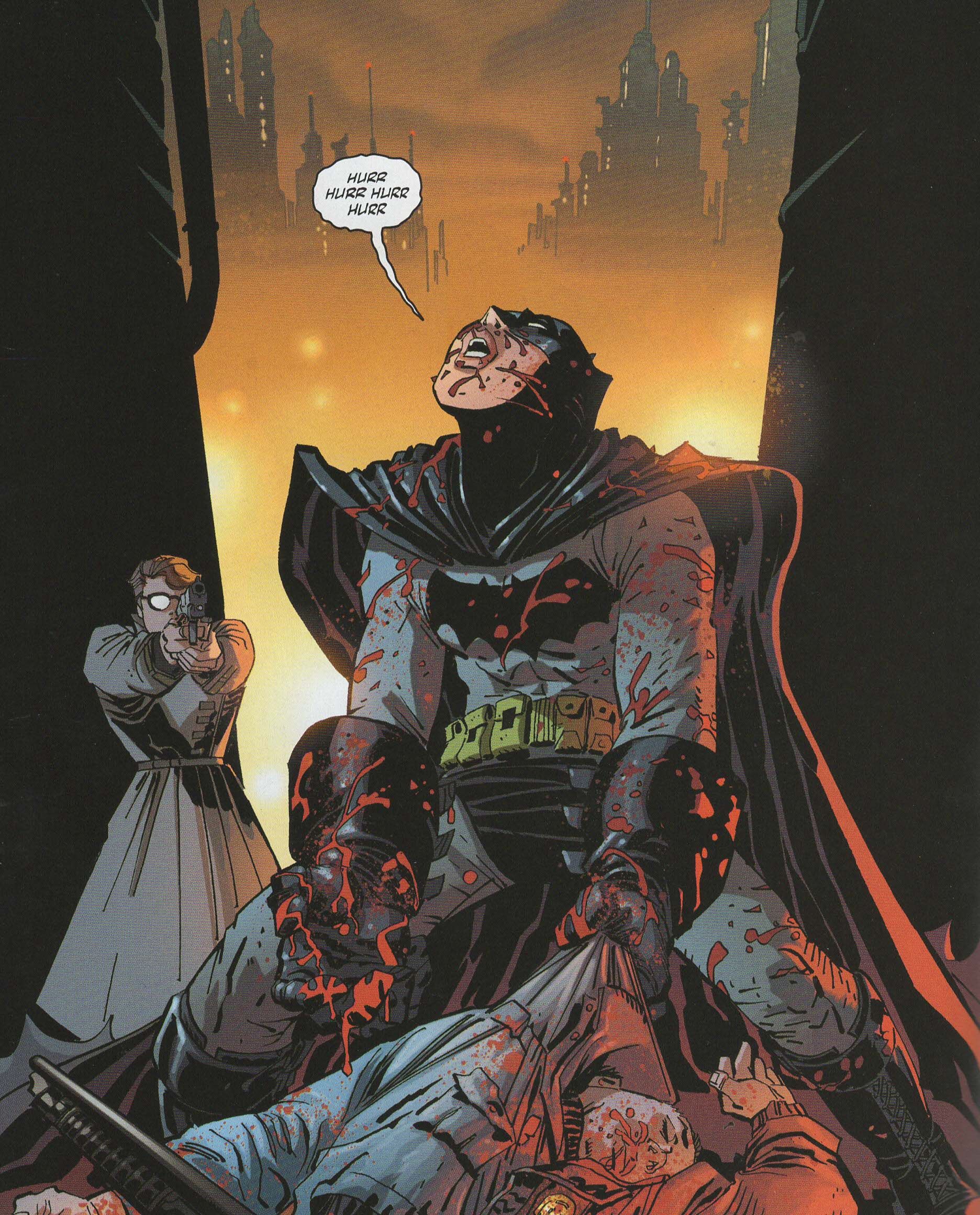Could you feel it coming? Did you think, "You know, this is the kind of comic that Greg likes to turn his baleful eye upon"? Well, you thought correctly. I tried to resist its power, I really did, but I could not, so let's break it down, page-by-page style!
As I've done the last few times I've done these, I have yet to read DKIII - this is all first impression. That just makes it more fun. For those of you who don't know, this isn't really Frank Miller's baby - I don't even know if he's provided the plot. Brian Azzarello is writing this (Miller gets a "story by" credit, but in interviews, it sounds like his part was limited to Azzarello sneaking a recording device into his bedroom after Miller had a crazy night of absinthe and blow and started rambling about Batman, so who knows what he really contributed?), Andy Kubert is penciling it, Klaus Janson is inking it, Brad Anderson is coloring it, Clem Robins is lettering it, Dave Wielgosz (assistant editor), Rebecca Taylor (associate editor), and Mark Doyle (editor) are editing it, and DC has the unmitigated gall to charge $5.99 for it. Gawd-dang! So let's check this bad bear out! (With, perhaps it's needless to say, MASSIVE SPOILERS for, you know, pretty much every page. That's just the way it is!)
Page -2: There are five (5) official variants, and forty-seven (47!!!!) "retailer variants." Does anyone remember the 1990s?
Page 1: Someone smashes the glass display that holds a Batman costume. In the first panel, we get a large, overbearing drawing of the top half of the outfit, and in the last panel, we get a long shot of the destroyed case, with the costume gone. Batman (presumably) narrates that there's no such thing as a good death, while two people are texting (or whatever the equivalent in this world is) about one of them having seen ("Cn") Batman and the other calling bullshit. Thirty years ago, as far as I recall, DC allowed some cursing in the first iteration of this comic. Now, we get "bs" and "fu". The person who has claimed to "Cn" Batman is called "Squid."
Page 2: The texting continues, as Squid apparently convinces the other person that Bats is back, and he (she?) also says that Batman has always been on "their" side, meaning he's not a cop. The narration is over the art, which shows a young black man getting chased by a police car. The police car has a cracked windshield and blood on its driver-side front window. The black man is trying to run without having tied his shoes. That's just dumb, man!
Page 3: So the young black man is Squid, as he's narrating events that have happened to him - in his texts, he says he was about to get arrested and/or shot by the cops, who block him with their car, but before they could do so, Batman showed up and took them down. He managed to get photos of Bats, which he now sends to his friend. At the very end of the page, a new narration picks up with "This is not something you're going to want to see --", which is kind of awkward phrasing, but no big deal. The coloring on the page is great - Anderson uses only police reds and blues in the first six-panel grid to show how close Squid is to the cop car, and I wonder if when Squid thinks he's going to get shot, the panel is blue (for death) and when he hears the "snap" as Batman starts breaking bones, the panel is red for violence. I'd like to think that's what was on Anderson's mind, but we'll never know, will we?
Pages 4-5: A double-page spread of Gotham, with Miller's signature televised talking heads spread out along the bottom in three stacked rows. Kubert makes the "televisions" square, unlike in the original, when rounded televisions were still the thing, and it's a nice acknowledgement of technological advances. I recognize "Michael Strahan" and "Kelly Ripa" on one screen, "Bill O'Reilly" on another, "Al Sharpton" giving a press conference, and "Jon Stewart" making a lame joke. I don't recognize the blonde lady, but Kubert does a really nice job with her, making her calm in her first appearance before turning on the rage the second time we see her. It's pretty neat. They're all ranting about Batman beating up cops, some pro and some con. That seems about right.
Page 6: Commissioner Yindel (hey, she's still around!) is about to give a press conference, when a lawyer hired by the mayor for public relations gives her a prepared statement about Bats. She doesn't look happy about it, and we don't know what she says to the reporters, as the scene ends at the end of the page. Yindel seems pretty easy to draw - she wears an overcoat, she has a business haircut - but Kubert channels Miller really well with her, especially in the final panel when we view her from below as she stands in front of the reporters. Well done, Mr. Kubert!
Page 7: We get a scene shift to a jungle, and someone narrating about the natives, whom we see holding bows and about to attack something. The natives are afraid, "and they will be, until they are what they are most afraid of ... dead." Man, that's some tortured phrasing. They're hunting a minotaur/centaur (a minocentaur?), as we see at the bottom of the page, but Kubert does a decent job trying to keep us in suspense, leading our eyes down the page, showing the tribe and the fear in their eyes, the jungle around them, the tips of their arrows, before the creature bursts from the trees and arrows fly at it. Kubert uses thin lines for the minotaur and lets Janson do the heavy lifting with the blacks, and it's really nice. I'll write more about the art when I'm done, but so far, Janson is really bending Kubert's pencils to his will (as he often does), so it's nice to see them working a bit more in concert here.
Page 8: I assume Wonder Woman is narrating, as she's the star of this scene. She's wondering how often "we" have saved "them" as she watches the minotaur trash the natives before she leaps from the bushes and into the fray. The minotaur is suitably impressive, and we get a Miller-esque silhouette of Wondy with only her shorts, breastplate, and tiara visible. The panel where she looks out from the bushes is very "Lord of the Flies."
Page 9: It's a full-page splash, as Wondy jumps up to punch the minotaur, who is all brokeback, which cracks me right up. That minotaur's spine sure is flexible! Nice work by Kubert, although the minotaur's front legs look a bit puny. Wonder Woman has a baby-filled papoose on her back.
Page 10: Wondy narrates the same thing she always does - that they save the unwashed masses, who love them until they hate them, but they still save their worthless, small lives. Frank Miller's Wonder Woman is kind of a jerk. Kubert gives us four panels and Wondy blocking a minotaur punch, then flipping over it and landing on its neck, which is pretty neat, although it worries me how tightly that kid is strapped into the papoose so that it doesn't fall out when Wondy goes upside-down. Plus, the scale is totally fucked up. On the previous pages, the minotaur is big, but not too big. When it's on its hind legs on Page 9, it's maybe 10 feet tall if Wonder Woman is a good 6 feet. On the very next page, the minotaur is able to grab Wonder Woman entirely in its fist and Wondy lands on its neck like she's an insect. The thing looks as big as Galactus in the first four panels. Then, in Panel 5, when she wrestles it to the ground, she's able to get her arm-span a good way around its neck. In Panel 6, she's once again relatively tiny. It's really weird, because someone had to have seen that, right? The book has three editors, after all. Still, Panel 7, in which Kubert gives us a close-up of Wonder Woman glowering in the rain, is pretty neat. And I love the kid's surprised look in Panel 5, as if it's saying, "Well, if my diaper didn't already need changing, it needs it now!!!"
Page 11: Wondy stands on the minotaur and wonders (get it!) what "wounded" her love so much as the baby (her son, we discover) starts crying. She soothes by breastfeeding it. Rather surprisingly, we actually see Amazon nipple, as she removes part of her breastplate, which means that the breastplate isn't a complete, fused piece, but one of different parts. Interesting. The final panel of the page zeroes in on the back of the baby's head as it suckles and Wondy tells him that the world is safe again. I really want this to be a commentary about the infantile nature of superhero fans, but I don't think it's that deep.
Page 12: Is that another full-page splash? Why, yes it is! Wondy tells her son that they're home as she stands near the walls of wherever it is that she lives (Themyscira, I guess, but who knows?) It's a nice drawing - it's deep in the jungle, so everything is covered with growth, and there are ziggurats as far as the eye can see, but really? A full-page splash?
Page 13: Wondy enters the city, where a group of women (advisers?) welcome their queen. She almost slices a throat when one woman says she'll take the baby (tellingly named Jonathan), but she apologizes quickly. Wondy needs to switch to decaf, I guess. She also tells Dessa (Dessa?) that she has a training session with her daughter, Lara, but Dessa tells her Lara is gone. Apparently this is not a surprising occurrence. There's nothing terribly notable about the art, except it looks more "Kubert" than most of the pages so far.
Page 14: Wait, another full-page splash? Dear sweet Jeebus. I mean, technically, it's two panels, but there's a small inset panel showing a very Miller-esque Lara, complete with terrible military-style hair cut and one earring floating just below her right ear, but it's still essentially a full-page splash, with Lara hovering outside the Fortress of Solitude while Wonder Woman's narration voice-over asks why Lara can't leave him be. There's really nothing more dramatic in full-page splashes than people standing outside places to live looking at them. It gets the blood pumping!!!
After this page, we get the first mini-comic, featuring the Atom and John "Superman" Holmes on the cover. Man, I don't care about Superman's dick, but that's a terrible drawing of Superman in general, although it's kind of par for the course for Miller these days. I'm not going to go through it page-by-page, but it's not bad. Miller's interior art, surprisingly, is a lot better than the cover - it's still late-era Miller, but more focused than it's been in years, and I wonder if that's because Janson is inking it or because Lynn Varley isn't coloring it. It's pretty solid, in other words. It does contain a pretty serious SPOILER for the end of the comic, which makes me wonder why DC put it in the middle of the book and didn't write "Don't read until the end!" on it. Kind of bizarre. But let's return to the regularly scheduled comic, already in progress!
Page 15: Lara enters the Fortress, in which everything is covered with snow. There are all sorts of Supermamorabilia from his various adventures, and Lara says she was told they were important. "That they were the parts that meant something that defined a whole ..." Yes, there are three "that"s in that sentence. Man. Anyway, Lara looks up and wonders if she's a "piece of the part ..." and we know she's going to say "or the whole" on the next page, but it's time for a page turn!
Page 16: Oh look, another full-page splash with a small inset panel so it's not officially one. At least this one is impactful, as Superman sits on his chair, completely encased in ice. Oh dear. In the inset panel, we see Lara's eye, tears leaking from it, and Superman reflected in it, as she asks why he let the "ants" knock him from the sky. So sad!
Page 17: While she's asking Ice Cube Man if there's anything she can do, she hears a "skree skree" in the background. I like how, because it's comics and this happens a lot, her ponytail somehow defies gravity even when she's standing still, as it does in Panels 1 and 2. It does it in Panels 3 and 4, too, but you can make the case that she's flying in those, so it's not as silly. Anyway, she follows to sound to Kandor, which is on a snow-covered pedestal. On the inside of the glass, the inhabitants have burned "Help Us." Right below it, in a narrative box designed to lead us to the next page, it reads: "Today the most powerful man on Earth --"
Page 18: Of course they're not talking about Superman, but the president of the U.S., who has to take a DNA test to prove he's actually the person he claims to be (that's a callback to The Dark Knight Strikes Again, in case you've forgotten or, more likely, actively had that removed from your memory by SCIENCE!). It's strange how the box changes - on Page 17, it was a standard white box with the book's regular lettering, but when we turn the page, it's in a box with rounded corners, a different color scheme, and "news" font. Why didn't the previous narrative box match it? We know that writers use those narrative boxes to transition between scenes, and that the first part was, most likely, not referring to Superman even though he is the most powerful man on Earth, so it's not like it's a surprise when we find out the news is talking about the president. It seems like a silly misdirect. But oh well.
Anyway, the news is getting us up-to-date on things in the world, including crazy behavior on Wall Street, Batman sightings, and police corruption. Dominating the panel is the Bat-signal, which Yindel stares up at and wonders how things got this way. She wonders when everyone stopped "thinking" and why Batman is back. As she ponders, a cop shows up and claims they have him. Yindel smiles.
Page 19: Batman is racing down the street, pursued by at least four police cars. Bats manages to cut them off by zipping between two large trucks, but there are a bunch in front of him, as well. He screeches to a stop before he runs into them.
Page 20: The cops have Bats boxed in a small street (nice work on the colors here, as the headlights look like lasers pinning him into place), but he uses his grappling hook (GRAPPLING HOOK!) to grab a handy fire escape and swing up. In a poorly-drawn panel, his motorcycle crashes into a cop car - it appears that the bike landed on the car, but it's really not clear. Kubert gets to draw Brooding Bats on the fire escape, as he looks down at the cops. Will he escape or will he fight? Do you even need to ask?
Page 21: A cop shines his flashlight up, which provides groovy illumination for Bats coming down, landing on the hood of a car and challenging the police. Nice work on the blacks in the panel, as the light in Batman's face throws his cowl into sharp relief on his flowing cape, while the cops around him are shrouded in shadows very well. Bats snatches the flashlight, bashes one cop on the head with it, and jumps toward the rest. Things are not looking good.
Page 22: More fighting. An uppercut from Bats lifts a policeman at least six feet off the ground, which is a nice visual but is, let's face it, pretty ridiculous. Then he punches two cops and kicks a third at the same time, which is, of course, because he's GODDAMNED BATMAN. But then a cop gets off a shot that clips him on the side of the head. DOWN GOES BATMAN! DOWN GOES BATMAN! DOWN GOES BATMAN!
Page 23: The cops converge on our prone hero, and we get a nice panel. Kubert curves the ground slightly upward to offer Bats like a sacrifice - he's in the foreground, and the mass of cops in the background are a faceless, baton-carrying mob, with the cars' headlights acting like floodlights criss-crossing behind them. It's a really nice way to set up the beatdown to come. Because the next nine panels are all about the beatdown, as the cops attack. Kubert alternates with showing silhouettes of the cops, sticks raised, and overhead shots of Bats lying on the ground taking the beating. The "whack" sound effects get larger as the beating continues, which is a nice touch.
Page 24: The first panel is well done, as the cops stand around the body and ask if Bats has had enough. Kubert uses long, ragged shadows to form a makeshift cage around the body, which is neat. One of the cops flips the body with his foot, and with a surprised look on his face, he says, "Fellas, this is a --" as we reach the end of the page.
Page 25: From the left side of the panel, a fist explodes into his face, breaking several bones, I should think, and spraying blood everywhere. In the next six small panels, we see the cops scattered like leaves, despite the fact that nine cops just pounded on Bats for quite a while with nightsticks and probably hit his head at least once or twice. Batman should barely be alive, yet here he is tearing through the police. Sigh. Anyway, the final panel is just a blood-covered Batman, facing to the right (to lead us off the panel), while on the left, in the white background void, a voice yells "Freeze!"
Page 26: It's Yindel, holding a gun on Batman, who crouches over a cop, breathing heavily (and loudly). As Yindel's eyes widen, Batman takes a swing in the final panel on the page. But who is he swinging at? The cop he's holding? And is that small burst of color on the right side of the panel supposed to be a gun shot, even though Yindel's gun is aimed squarely at his back? It's kind of odd.
Page 27: More oddness, as we get a 2 x 3 column of panels in the upper left corner that seem to indicate that Bats is trying to punch the cop he's holding, even though there's no cop in the panel. As Yindel says it's over, Bats turns to her and lunges at her, but she avoids the punch and manages to get cuffs on his wrist. So I guess he was about to punch the cop but was too exhausted to follow through, which allowed Yindel to cuff him? Is that what we're thinking happened? Anyway, Yindel asks Bats "Where is Bruce Wayne?", which is a bit strange until we get the big reveal in the bottom right of the page, which is that Batman is actually a woman. Here's the other strange thing: Yindel asks where Bruce Wayne is, and then begins to repeat the question. She pulls the mask off to reveal Carrie Kelly (I guess), who then repeats the question. I guess she's just making sure she heard correctly, because why would she want to know the answer and why would she think Yindel knows? The question ends with an ellipsis, which means it leads to a page turn!
Page 28: Ah, Carrie was just repeating the question for effect, as she answers it with "Bruce Wayne is dead." I see. Nice way to close the issue, with a shaft of light falling from the upper left to the bottom right, passing over the sprawled bodies of the cops and illuminating Carrie and Yindel. Despite the fact that Yindel is arresting Carrie, it still looks like she's comforting her, as Carrie is curled a bit and the cape curls around her, forming a protective circle, while Yindel squats next to her, but from above, it almost looks like she's holding Carrie's head in her lap. It's a nice image.
**********
Well, that was certainly something, wasn't it? I mean, it's not bad, but it's not great, either. It's 28 pages of set-up, which seems like a lot. Azzarello never met a page he couldn't turn into five (he's not as bad as Bendis, the master of decompression, but he's no slouch, either), so it feels padded, even though it's the first issue and should be going off like gangbusters (five full-page splashes and one double-page splash will do that). Like a lot of comics these days, there's a lot of fat that could be trimmed, but that's the way it is. Kubert's art is fine (I tend to like both Kubert sons' art, although I know they have their detractors), and it's interesting to see some different pages where Janson's influence was greater. Whatever you think of Janson, he might be the most influential modern inker, because his line work is so heavy-handed that he often turns any artist into "Janson-lite," which is kind of strange. The first few pages, with Squid running from the cops, is very Janson-esque, with thick lines stiffening and simplifying the figures, so a few panels look almost like Romita Jr., whom Janson has inked a lot in the past. Janson even turns Miller into "Janson-esque," which is why Kubert is doing a decent Miller impression on several pages. I kind of wish Kubert had made this more his own, which is why the pages that are less Miller/Janson, such as Wonder Woman talking to her advisers or the Bats/cops fight at the end are my favorite pages. But Kubert does some nice things, and he knows how to make a comic, so the book looks fine, except for the weird scale problem when Diana fights the minocentaur.
Part of the problem with it is that Azzarello and Kubert are trying to do Miller, but they're not Miller. For good or evil, Miller's books feel like events, and as terrible as DKSA was (again, I know smart people think it's great, but even smart people can be wrong occasionally!), it felt like a big, bodacious slab of comics insanity. This comic feels like ... yet another Batman story. Without Miller's over-the-top writing and over-the-top artwork, this loses some of the spectacle that DC wants it to be. It's too bad. Go fucking big or go fucking home, right?
I also think the book is hurt by DC not publishing Prestige Format books anymore. I assume the economies of scale have caught up to them, but those Prestige Format books (both previous iterations of this series were released that way) made the stories feel important. They were longer, square-bound instead of stapled, and the paper stock was better. Now, the glossy paper we get in a lot of "regular" DC books these days means that the latter point in Prestige Format books no longer matters, but the other two hold true. This feels like a "normal" comic, with none of the attendant bells and whistles, even with the mini-comic thrown in. It's kind of a shame, even more so because if DC decided to do four Prestige Format issues rather than eight normal ones, this might not have felt like so much padding because the second issue would have been included. I know why DC does it - they need to pay the talent, and while I very much believe they could easily charge a dollar or even two less for this thing (it definitely feels like a $4.99 book, and six is way too much), if they keep going with these with the same price, you'll pay $48 (!!!!) for the entire mini-series. I don't know if it's been proven, but comics consumers seem to want to buy smaller increments for lower prices than larger increments for the same price as the two smaller increments would be together. Therefore, if DC released this as a nice, 60-page Prestige Format book and made it Part One of Four, they'd charge (theoretically) $11.99 for it, and I wonder if they're terrified that no one would buy it even though, math-wise, it's the same price. And the format would be nicer. This book should feel like an event. Without Miller being a lunatic and without the fanciness of the format, it's still a solid comic, but it feels like so many other Batman books that have come out in the past 15 years.
Of course, maybe that's just me. I'm sure this will sell like crazy, and the Internet will treat it as important even though it's not really, and everything will be fine. It's a Batman comic. It's not an insane, holy-shit-this-is-awesome Batman comic like the first one, nor is it an insane, holy-shit-what-the-fuck-happened-to-Frank-Miller Batman comic like the second one. It's a perfectly fine but fairly forgettable Batman comic. That's probably its biggest sin.
Rating: ★ ★ ★ ★ ★ ☆ ☆ ☆ ☆ ☆

